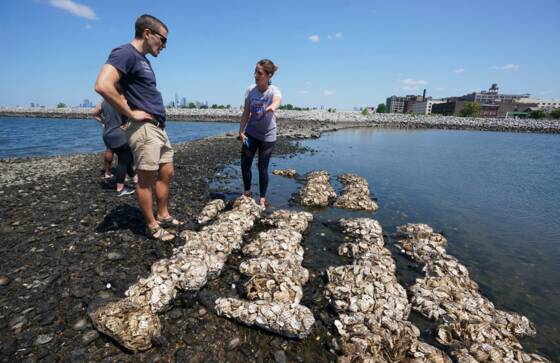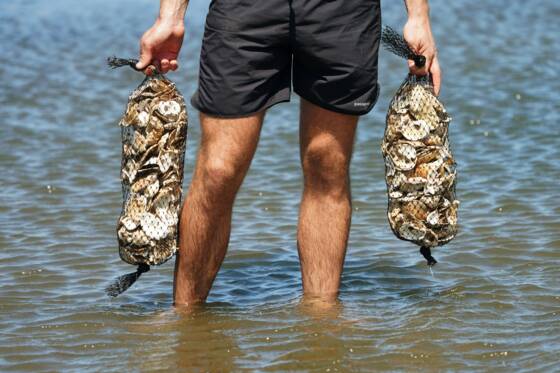On a beautiful sunny morning, a dozen biologists and volunteers get busy, with their feet in the water, in a coastal neighborhood of Brooklyn. Their goal: to build an oyster reef, as part of a large New York oyster reef restoration project.
In fishing suits and rubber boots, the group forms a human chain that stands out against the skyline of America’s financial capital, with the Statue of Liberty and the Wall Street skyscrapers as a backdrop.
The team throws nets filled with empty oyster shells or shells into which up to 20 young oyster larvae have been introduced. Then arrange them in rows at the bottom of the water, to form the reef.
“Oysters are engineers of the ecosystem and build a habitat (…) where other species also like to come to hunt or live”, explains to AFP Katie Mosher, head of the restoration project “Billion Oyster Project” (“One billion oysters” by 2035), launched in 2014 not for gastronomic purposes but for the environment.
These mollusks also play an important regulatory role: they filter water by breathing, allowing more light to pass through and the growth of more aquatic plants.
– Big Apple or Big Oyster –
They also recycle nutrients and nitrogen. And, by forming dense clusters, serve as a natural bulwark against erosion, or in the event of storms or hurricanes.
“Before becoming the Big Apple, New York was the Big Oyster,” said Mike McCann, marine ecology expert for the environmental organization The Nature Conservancy, which leads other oyster restoration projects, notably in Hong Kong.
“It’s a story that many New Yorkers have forgotten, and that this project brings to life,” said the 32-year-old environmentalist.
When English explorer Henry Hudson entered New York Harbor in 1609, he was forced to navigate 89,000 hectares of oyster reefs, which the Lenape Indians had fed on for generations, says Mark Kurlansky in his 2006 book, “The Big Oyster “(The Big Oyster).
The Dutch settlers of New Amsterdam also nicknamed Ellis Island and Liberty Island, now very touristy, “Small oyster island” and “Big oyster island”.
But at the start of the 20th century, with overfishing and pollution, mollusks almost disappeared from the waters surrounding the American megalopolis.
For many decades, these waters were too toxic, preventing virtually all aquatic life. The latter only succeeded in gradually reviving it after the adoption in 1972 of the Clean Water Act, which prohibited the discharge into the port of waste and untreated sewage.
Today, restoration efforts, involving dozens of partners and more than 100 public and volunteer schools in many New York City coastal neighborhoods, are beginning to bear fruit.
– Giant oyster –
More than 28 million oysters have already been reintroduced in four years and the health of the port has never been so good in 150 years, according to project officials.
“When you put oysters in the bottom of the water, you immediately notice an improvement: there are more fish, more crabs”, langoustines and even seahorses, says Katie Mosher.

The restored reefs also promote the growth of wild oysters: sometimes a giant oyster, like the 8-inch oyster that emerged from the Hudson River in August, near Manhattan’s TriBeCa district, the largest in a century. .
In some areas, the larvae are so numerous that it is enough to offer them a support to settle, says Mosher.
“I had no idea there were oysters in New York!” Enthuses Emma Latham, 22, a volunteer who recently graduated in ecology from Princeton University. “The environmental impact of a place with so many people living in such a small space, with so much concrete, is so terrible that all the little things that can be done to make it better is great.”
The project closely follows the evolution of the reefs built all along the New York coast, from the Bronx to Queens.
“We’re interested in basic things: Are oysters growing? Do they survive? Do they reproduce and create a sustainable population?” Says Mike McCann.
Water quality, predators, diseases, quantities of fish are the subject of regular analyzes and surveys, a work carried out in part by students from New York schools, who also study oysters in class.
– Inedible –
New Yorkers swallow an average of half a million oysters a week, and the project collects piles of shells from some 70 restaurants each week, which must then be dried and purified.

It is only after one year that the shells can be used for reef formation or the insertion of laboratory-grown larvae.
As the quantities of shells to build the reefs are limited, the project must resort to other methods: it has even crushed thousands of porcelain toilet bowls from New York schools …
As flourishing as the initiative is, New York oysters remain inedible: the wastewater treatment is not reliable enough, and on heavy rainy days, the water overflows and can contaminate the bay.
“We probably won’t be able to eat them in our lifetime,” says Mosher. “Their function here is to improve the habitat and the health of the port.”
–


